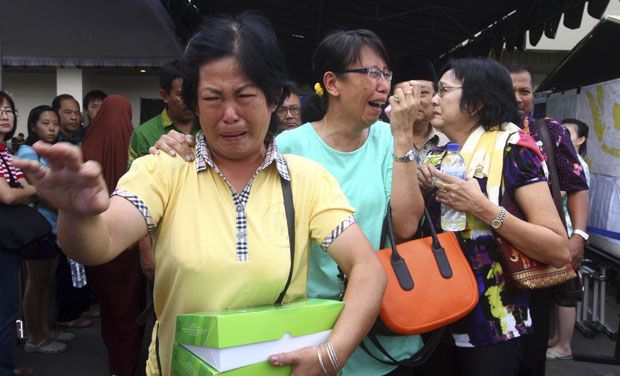
Surabaya, Indonesia/Jakarta: A body recovered on Wednesday from the crashed AirAsia plane was wearing a life jacket, an official with Indonesia’s search and rescue agency said, raising questions about how the disaster unfolded.
Rescuers believe they have found the plane on the ocean floor off Borneo, after sonar detected a large, dark object beneath waters near where debris and bodies were found on the surface.
Ships and planes had been scouring the Java Sea for Flight QZ8501 since Sunday, when it lost contact during bad weather about 40 minutes into its flight from the Indonesian city of Surabaya to Singapore.
Seven bodies have been recovered from the sea, some fully clothed, which could indicate the Airbus A320-200 was intact when it hit the water. That would support a theory that it suffered an aerodynamic stall.
The fact that one person put on a life jacket would appear to indicate those on board had at least some time before the aircraft hit the water, or after it hit the water and before it sank.
And yet the pilots did not issue a distress signal. The plane disappeared after it failed to get permission to fly higher to avoid bad weather because of heavy air traffic.
“This morning, we recovered a total of four bodies and one of them was wearing a life jacket,” Tatang Zaenudin, an official with the search and rescue agency, told Reuters.
He declined to speculate on what the find might mean.
Hernanto, head of the search and rescue agency in Surabaya, said rescuers believed they had found the plane on the sea bed with a sonar scan in water about 30 to 50 meters (100 to 165 feet) deep. The black box flight data and cockpit voice recorder has yet to be found.
Authorities in Surabaya were making preparations to receive and identify bodies, including arranging 130 ambulances to take victims to a police hospital and collecting DNA from relatives.
“We are praying it is the plane so the evacuation can be done quickly,” Hernanto said.
Most of the people on board were Indonesians. No survivors have been found.
Officials said waves two to three meters (six to nine feet) high and winds were hampering the hunt for wreckage and preventing divers from searching the crash zone.
“The fact that the debris appears fairly contained suggests the aircraft broke up when it hit the water, rather than in the air,” said Neil Hansford, a former pilot and chairman of consultancy firm Strategic Aviation Solutions.
Indonesian President Joko Widodo said his priority was retrieving the bodies.
Widodo, speaking in Surabaya on Tuesday after grim images of the scene in the Java Sea were broadcast on television, said AirAsia would pay an immediate advance of money to relatives, many of whom collapsed in grief when they saw the television pictures from the search.
AirAsia Chief Executive Tony Fernandes has described the crash as his “worst nightmare”.
About 30 ships and 21 aircraft from Indonesia, Australia, Malaysia, Singapore, South Korea and the United States have been involved in the search.
Singapore said it was sending two underwater beacon detectors to try to pick up pings from the black boxes, which contain cockpit voice and flight data recorders.
BAD WEATHER
The plane was travelling at 32,000 feet (9,753 meters) and had asked to fly at 38,000 feet. When air traffic controllers granted permission for a rise to 34,000 feet a few minutes later, they received no response.
Online discussion among pilots has centered on unconfirmed secondary radar data from Malaysia that suggested the aircraft was climbing at a speed of 353 knots, about 100 knots too slow, and that it might have stalled.
Investigators are focusing initially on whether the crew took too long to request permission to climb, or could have ascended on their own initiative earlier, said a source close to the inquiry, adding that poor weather could have played a part as well.
A Qantas pilot with 25 years of experience flying in the region said the discovery of the debris field relatively close to the last known radar plot of the plane pointed to an aerodynamic stall. One possibility is that the plane’s instruments iced up, giving the pilots inaccurate readings.
The Indonesian captain, a former air force fighter pilot, had 6,100 flying hours under his belt and the plane last underwent maintenance in mid-November, said the airline, which is 49 percent owned by Malaysia-based budget carrier AirAsia.
Three airline disasters involving Malaysian-affiliated carriers in less than a year have dented confidence in the country’s aviation industry and spooked travellers.
Malaysia Airlines Flight MH370 went missing in March on a trip from Kuala Lumpur to Beijing with 239 passengers and crew and has not been found. On July 17, the same airline’s Flight MH17 was shot down over Ukraine, killing all 298 people on board.
On board Flight QZ8501 were 155 Indonesians, three South Koreans, and one person each from Singapore, Malaysia and Britain. The co-pilot was French.
The AirAsia group, including affiliates in Thailand, the Philippines and India, had not suffered a crash since its Malaysian budget operations began in 2002.


